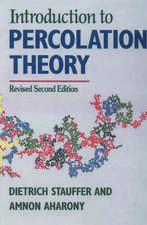High-Pressure Shock Compression of Solids III: Shock Wave and High Pressure Phenomena
Editat de Lee Davison, Mohsen Shahinpooren Limba Engleză Paperback – 17 sep 2011
Din seria Shock Wave and High Pressure Phenomena
- 15%
 Preț: 651.67 lei
Preț: 651.67 lei - 24%
 Preț: 804.03 lei
Preț: 804.03 lei - 18%
 Preț: 2099.77 lei
Preț: 2099.77 lei - 18%
 Preț: 1111.97 lei
Preț: 1111.97 lei - 15%
 Preț: 645.28 lei
Preț: 645.28 lei - 18%
 Preț: 948.29 lei
Preț: 948.29 lei - 15%
 Preț: 532.38 lei
Preț: 532.38 lei - 18%
 Preț: 1235.25 lei
Preț: 1235.25 lei - 18%
 Preț: 1132.65 lei
Preț: 1132.65 lei - 18%
 Preț: 1228.96 lei
Preț: 1228.96 lei -
 Preț: 397.01 lei
Preț: 397.01 lei - 18%
 Preț: 949.10 lei
Preț: 949.10 lei - 15%
 Preț: 634.32 lei
Preț: 634.32 lei - 18%
 Preț: 1541.47 lei
Preț: 1541.47 lei - 24%
 Preț: 1040.54 lei
Preț: 1040.54 lei - 15%
 Preț: 642.03 lei
Preț: 642.03 lei - 18%
 Preț: 892.90 lei
Preț: 892.90 lei - 20%
 Preț: 560.55 lei
Preț: 560.55 lei - 18%
 Preț: 1390.73 lei
Preț: 1390.73 lei - 18%
 Preț: 947.50 lei
Preț: 947.50 lei - 18%
 Preț: 957.44 lei
Preț: 957.44 lei - 18%
 Preț: 1126.69 lei
Preț: 1126.69 lei -
 Preț: 384.70 lei
Preț: 384.70 lei - 15%
 Preț: 649.39 lei
Preț: 649.39 lei - 18%
 Preț: 1382.21 lei
Preț: 1382.21 lei -
 Preț: 392.21 lei
Preț: 392.21 lei - 15%
 Preț: 596.36 lei
Preț: 596.36 lei - 18%
 Preț: 1554.72 lei
Preț: 1554.72 lei - 18%
 Preț: 1228.29 lei
Preț: 1228.29 lei - 15%
 Preț: 644.30 lei
Preț: 644.30 lei - 18%
 Preț: 891.80 lei
Preț: 891.80 lei - 18%
 Preț: 951.14 lei
Preț: 951.14 lei - 15%
 Preț: 534.82 lei
Preț: 534.82 lei
Preț: 391.79 lei
Nou
Puncte Express: 588
Preț estimativ în valută:
74.97€ • 78.12$ • 62.07£
74.97€ • 78.12$ • 62.07£
Carte tipărită la comandă
Livrare economică 03-17 aprilie
Preluare comenzi: 021 569.72.76
Specificații
ISBN-13: 9781461274544
ISBN-10: 1461274540
Pagini: 360
Ilustrații: XIV, 341 p.
Dimensiuni: 155 x 235 x 19 mm
Greutate: 0.5 kg
Ediția:Softcover reprint of the original 1st ed. 1998
Editura: Springer
Colecția Springer
Seria Shock Wave and High Pressure Phenomena
Locul publicării:New York, NY, United States
ISBN-10: 1461274540
Pagini: 360
Ilustrații: XIV, 341 p.
Dimensiuni: 155 x 235 x 19 mm
Greutate: 0.5 kg
Ediția:Softcover reprint of the original 1st ed. 1998
Editura: Springer
Colecția Springer
Seria Shock Wave and High Pressure Phenomena
Locul publicării:New York, NY, United States
Public țintă
ResearchCuprins
1 Equation of State at High Pressure.- 1.1. Introduction.- 1.2. General Considerations.- 1.3. Some Results.- 1.4. Summary.- References.- 2 Molecular Dynamics Analysis of Shock Phenomena.- 2.1. Introduction.- 2.2. Model and Methods.- 2.3. Nonenergetic A2 Piston-Driven Simulations.- 2.4. Energetic Chemically-Sustained Shock Waves.- 2.5. Conclusions.- Acknowledgments.- References.- 3 Mechanisms of Elastoplastic Response of Metals to Impact.- 3.1. Introduction.- 3.2. Dislocation Motion.- 3.3. Plastic Strain Rate.- 3.4. Comparison with Experiments.- 3.5. High-Amplitude Shock Loading.- 3.6. Elastic and Plastic Waves in Shocks.- 3.7. Electroplastic Effects.- 3.8. Impediments to Dislocation Motion and Crystal Failure.- 3.9. Energy Dissipation by Moving Dislocations.- 3.10. Conclusions.- Acknowledgments.- References.- 4 Molecular Processes in a Shocked Explosive: Time-Resolved Spectroscopy of Liquid Nitromethane.- 4.1. Introduction.- 4.2. Optical Spectroscopy Probes.- 4.3. Shock Response of Nitromethane and Sensitized Nitromethane.- 4.4. Summary and Conclusions.- Acknowledgments.- References.- 5 Effects of Shock Compression on Ceramic Materials.- 5.1. Introduction.- 5.2. Shock Compression Studies on Some Selected Ceramic Materials.- 5.3. Yielding Mechanism and Correlation with Material Characterization.- 5.4. Effects of Shock Compression on Shock-Induced Phase Transition.- 5.5. Concluding Remarks.- References.- 6 Response of High-Strength Ceramics to Plane and Spherical Shock Waves.- 6.1. Introduction.- 6.2. Elements of Experimental Strategy.- 6.3. Uniaxial Deformation by a Plane Shock Wave.- 6.4. Triaxial Deformation by a Divergent Spherical Wave.- 6.5. Conclusions, Prospects, and Recommendations.- References.- 7 Initiation and Propagation of Detonation in Condensed-Phase HighExplosives.- 7.1. Introduction.- 7.2. Brief History of Condensed-Phase Explosive Technology.- 7.3. Planar Steady Detonation Theory.- 7.4. Equations Governing Reactive Flow.- 7.5. Initiation of Detonation.- 7.6. 2D Steady Detonation in Homogeneous and Heterogeneous Materials.- 7.7. Properties of High Explosives.- 7.8. Initiation and Detonation Measurement Techniques.- 7.9. Summary.- 7.10. Glossary.- Acknowledgments.- References.- 8 Analysis of Shock-Induced Damage in Fiber-Reinforced Composites.- 8.1. Introduction.- 8.2. Background.- 8.3. Micromechanical Model.- 8.4. Constitutive Models.- 8.5. Numerical Implementation.- 8.6. Computational Simulations.- 8.7. Summary.- Acknowledgments.- References.- 9 Attenuation of Longitudinal Elastoplastic Pulses.- 9.1. Introduction.- 9.2. Stress and Deformation Fields.- 9.3. Longitudinal Shocks.- 9.4. Material Response Model: Ideal Elastoplasticity at Small Strain.- 9.5. Shock Propagation in a Slab.- 9.6. Elastoplastic Pulse Attenuation.- 9.7. Summary and Conclusions.- 9.A. Appendix: Field Values for Pulse Attenuation in Range C.- 9.B. Appendix: Field Values for Pulse Attenuation in Range D.- 9.C. Appendix: Field Values for Pulse Attenuation in Range E.- References.- Author Index.

















